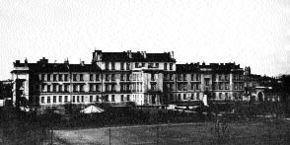Headquarters Warsaw, Poland | ||
 | ||
Similar War Studies University, Polish Air Force Academy, Tadeusz Kościuszko Land For | ||
Wyższa Szkoła Wojenna (English: War College—literally, "Higher War School") was the most important Polish military academy in the period between the World Wars. Located at Warsaw, it was established to train high-ranking officers of the Polish Army and of the armed forces of several allied states. It was a predecessor of Poland's present National Defense Academy (Polish: Akademia Obrony Narodowej).
History
After the rebirth of Poland in 1918, there was already a well-trained and experienced cadre of Polish field officers trained in the armies of the partitioners (Russia, Germany and Austria-Hungary) as well as in France. However, the occupants of Poland rarely promoted the Poles to higher ranks and the reborn Polish Army was seriously lacking officers trained in general staff duties and in command of entire armies. To eliminate the problem, in cooperation with the French Military Mission to Poland and the Paris-based Ecole Superieure de Guerre, a Szkoła Wojenna Sztabu Generalnego (War School of the General Staff) was formed in mid-1919.
After the Polish-Bolshevik War, on 16 August 1922, the school was renamed to Wyższa Szkoła Wojenna (WSW, Higher War School). Until 1928, most professors were French, with Polish officers serving mostly as their assistants. Among them was Charles de Gaulle, the future president of France, who was a professor of tactics. The training was not limited to military affairs and among the civilians working there were some of the most notable scientists of the era, including Tadeusz Kotarbiński, Edward Lipiński and Marian Kukiel. Apart from the theoreticians, the professors included a large number of officers who gained combat experience in World War I, Polish-Bolshevik War, Polish-Ukrainian War and Polish-Lithuanian War, as well as the Greater Poland Uprising and Silesian Uprisings. Because of their experience, the school became prestigious and attracted many students from abroad, most notably from France, Georgia, Estonia, Latvia and even Japan. Among them were also the officers of the former Ukrainian army of Semen Petlura and White Russian emigrees.
During the 20 years of its existence, the WSW trained more than 1300 officers of the Polish Army. Most of them repaid the debt for Poland during the Polish Defensive War of 1939, while the majority of professors formed the staff of Poznań Army, the most successful of Polish Armies in the 1939 campaign.
After Poland was overrun by Germany and the Soviet Union, the school was closed. However, on 11 November 1940 it was recreated in London. It trained the officers of the Polish Army in Exile, fighting alongside the Allies on all fronts of World War II. The professors were recruited from among the active officers of the Polish HQ and the students included many of the notable generals of the Polish forces in Exile. In addition, the school was the alma mater of all highest-ranking Czechoslovak officers of the exiled army. It was closed in 1946, after the Allies withdrew their support for the Polish government.
